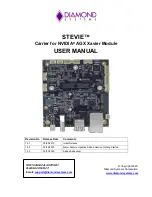
Stevie User Manual Rev 1.03
Page 12
The PCIe, USB 3.1, and UFS Transport Protocol Mapping on the AGX Xavier Series Module is delineated
in the table below.
Signal/Pin Name
Mapping
UPHY 0 (x1 PCIe)
Mini PCIe Card
UPHY1 (USB 3.1)
USB 3.1 Header Type A
UPHY [5:2] (x4 PCIe)
M.2 PCIe
UPHY 6 (USB 3.1)
USB 3.1 Header Type A
UPHY 7 (x1 PCIe)
I210 Ethernet Controller
UPHY8 (x1 PCIe)
PCIe to PCI Bridge
UPHY10 (x1 PCIe)
UFS Card Socket
3.10 PCIe MiniCard Socket
The baseboard is equipped with one Mini PCIe socket that supports full-size modules.
Two M.2 threaded spacers are mounted on the board for installing a full-size module. A USB 2.0 interface
is provided for plugging-in additional cards for expansion and connectivity.
The USB 2.0 port is shared between the USB 2.0 2x5 header at
J19
and the PCIE MiniCard socket.
To connect the USB 2.0 port to the PCIe MiniCard socket, mount the Jumper shunt on
J18
(USB Select)
location.
3.11 USB Ports
Stevie baseboard implements four USB 2.0 ports and two USB 3.1 ports. All ports are connected to 1 no. of
the 2x5 header.
By default, one USB 2.0 port is routed to the 2x5 header and can be switched to the MiniCard socket using
the Jumper option explained in
Section 3.10:
PCIe MiniCard Socket
above.
2x USB 2.0 port and 2x USB 3.1 ports are connected to Standard Dual USB 3.0 Type A
connector.
2x USB 2.0 ports are connected to 2x5 header One USB 2.0 port is Muxed between the MiniCard
socket and the USB 2.0 socket.
3.12 PCIe M.2 Socket
The baseboard provides a 2280 (22 mm wide and 80 mm long) form factor M.2 PCIe SSD module socket
with four PCIe lanes which are routed from the AGX Xavier Series Module.
Due to physical height constraints of the connector, only single-sided (S2, S3) 2280 M or B+M keyed SSD
modules are used on the Stevie baseboard.
3.13 UFS and Micro SD Socket
To enhance interoperability between devices, the baseboard supports a Universal Flash Storage (UFS) Card
and MicroSD Card Combo socket with options to insert either or both cards.
3.14 Data Acquisition (DAQ) I/O Interface
The baseboard implements DAQ functionality via:
Six Single-Ended (SE) Analog-Digital Converter (ADC) inputs or 3 Differential-Ended (DE)
Two Digital-to-Analog Converter (DAC) outputs
13 Digital I/Os through the SAM D51 Microcontroller Series Part No.



























